

Compact Muon Solenoid
LHC, CERN
| CMS-PAS-SUS-19-008 | ||
| Search for physics beyond the standard model in events with two same-sign leptons or at least three leptons and jets in proton-proton collisions at $\sqrt{s}= $ 13 TeV. | ||
| CMS Collaboration | ||
| March 2019 | ||
| Abstract: A data sample of events from proton-proton collisions with two isolated same-sign leptons or at least three leptons, and at least two jets, is studied in a search for signatures of new physics phenomena by the CMS Collaboration at the LHC. The data correspond to an integrated luminosity of 137 fb$^{-1}$, at a center-of-mass energy of 13 TeV. The properties of the events are consistent with expectations from standard model processes, and no excess yield is observed. Exclusion limits at 95% confidence level are set on cross sections for the pair production of gluinos or squarks for various decay scenarios in the context of supersymmetry models conserving or violating R-parity. The observed lower mass limits are as high as 2.1 TeV for gluinos, and 0.9 TeV for top and bottom squarks. | ||
|
Links:
CDS record (PDF) ;
CADI line (restricted) ;
These preliminary results are superseded in this paper, EPJC 80 (2020) 752. The superseded preliminary plots can be found here. |
||
| Figures | |
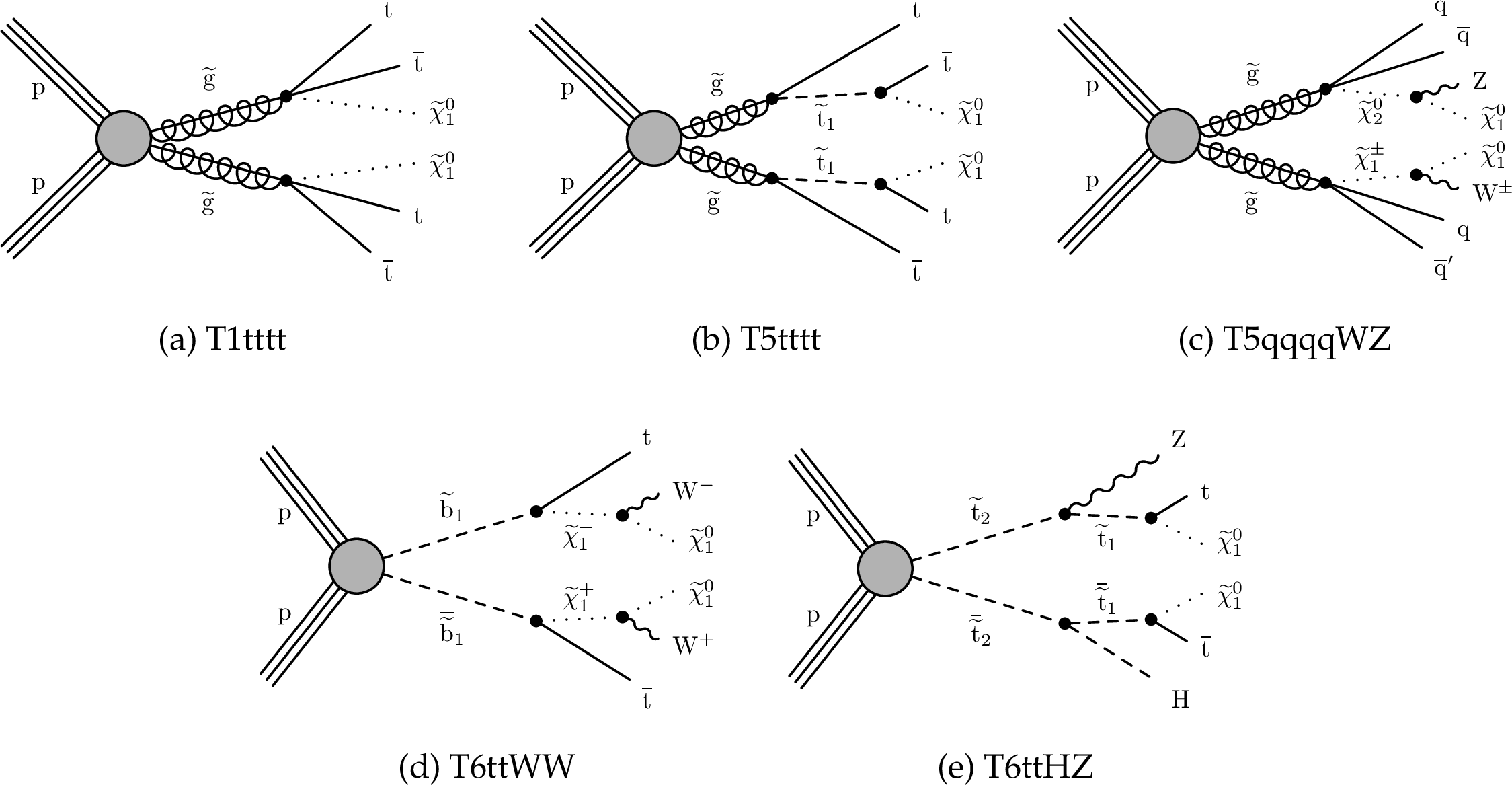
png pdf |
Figure 1:
Diagrams illustrating the simplified RPC SUSY models considered in this analysis. |

png pdf |
Figure 2:
Diagrams illustrating the two RPV SUSY models considered in this analysis. |
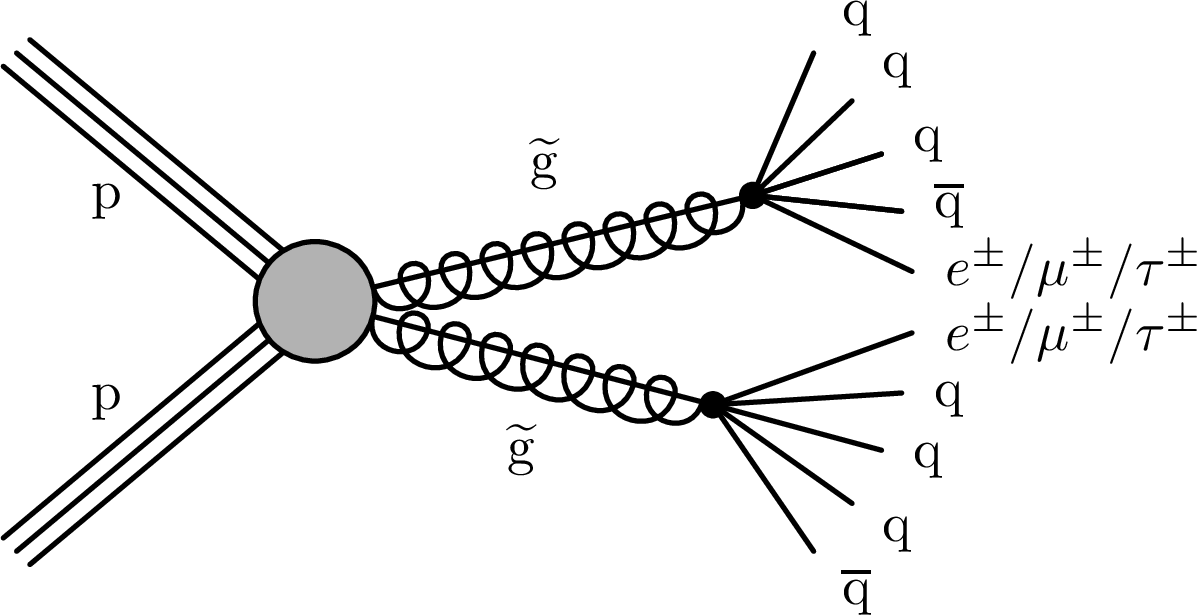
png pdf |
Figure 2-a:
Diagram illustrating one of the RPV SUSY models considered in this analysis. |
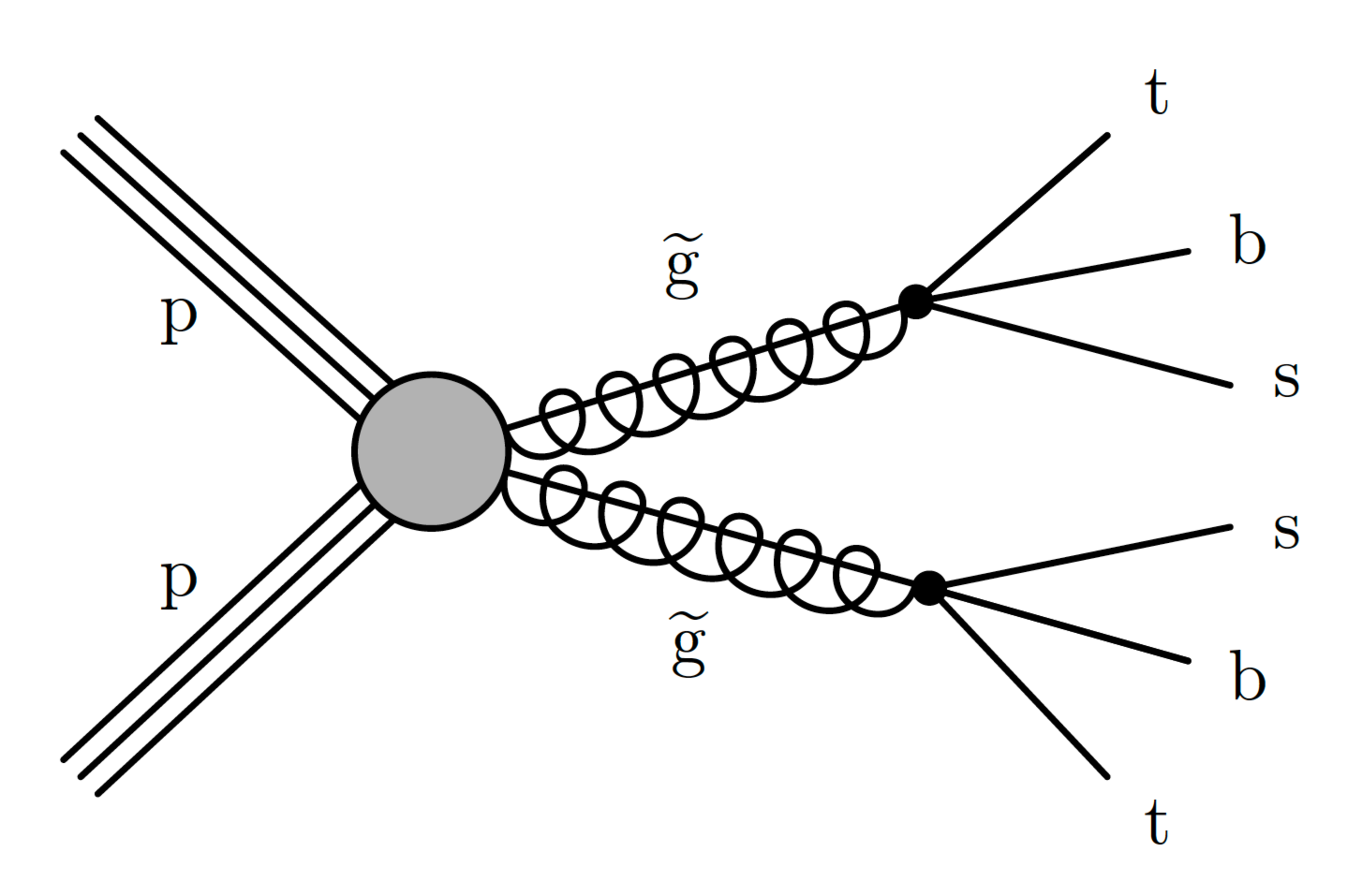
png pdf |
Figure 2-b:
Diagram illustrating one of the RPV SUSY models considered in this analysis. |
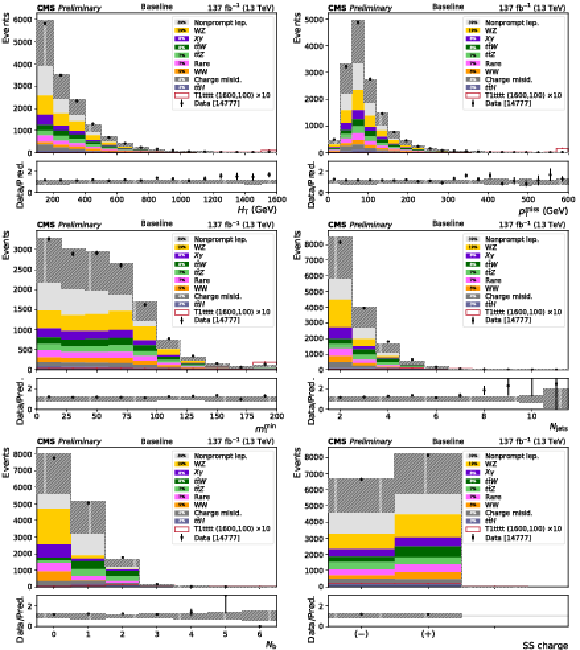
png pdf |
Figure 3:
Distributions of the main analysis variables after the baseline selection in all signal categories: ${H_{\mathrm {T}}}$, ${{p_{\mathrm {T}}} ^\text {miss}}$, ${m_\mathrm {T}^{\text {min}}}$, ${N_\text {jets}}$, ${N_{\mathrm{b}}}$, and the charge of the same sign pair, where the last bin includes the overflow. The hatched area represents the total uncertainty in the background prediction. The lower panels show the ratio of the observed event yield and the background prediction. |
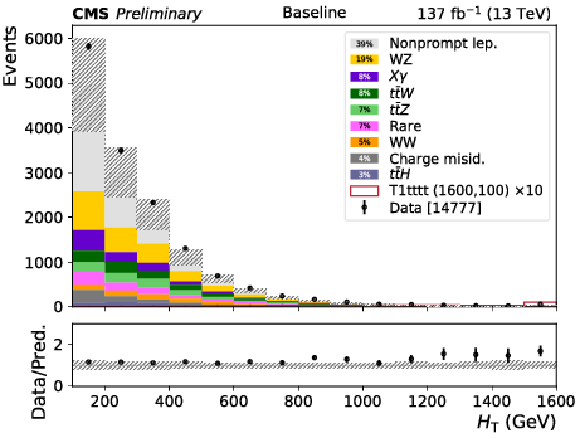
png pdf |
Figure 3-a:
Distribution of ${H_{\mathrm {T}}}$ after the baseline selection in all signal categories. The last bin includes the overflow. The hatched area represents the total uncertainty in the background prediction. The lower panel shows the ratio of the observed event yield and the background prediction. |

png pdf |
Figure 3-b:
Distribution of ${{p_{\mathrm {T}}} ^\text {miss}}$ after the baseline selection in all signal categories. The last bin includes the overflow. The hatched area represents the total uncertainty in the background prediction. The lower panel shows the ratio of the observed event yield and the background prediction. |
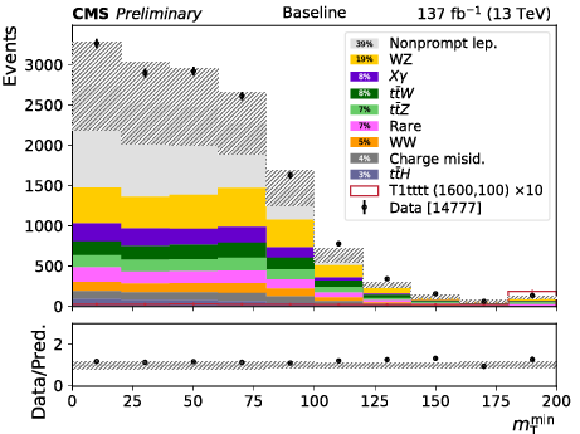
png pdf |
Figure 3-c:
Distribution of ${m_\mathrm {T}^{\text {min}}}$ after the baseline selection in all signal categories. The last bin includes the overflow. The hatched area represents the total uncertainty in the background prediction. The lower panel shows the ratio of the observed event yield and the background prediction. |
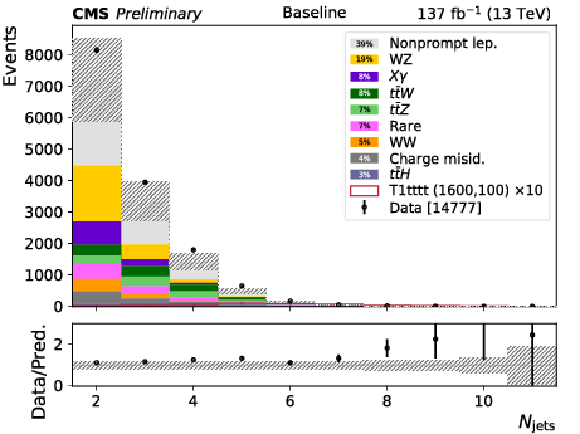
png pdf |
Figure 3-d:
Distribution of ${N_\text {jets}}$ after the baseline selection in all signal categories. The last bin includes the overflow. The hatched area represents the total uncertainty in the background prediction. The lower panel shows the ratio of the observed event yield and the background prediction. |

png pdf |
Figure 3-e:
Distribution of ${N_{\mathrm{b}}}$ after the baseline selection in all signal categories. The last bin includes the overflow. The hatched area represents the total uncertainty in the background prediction. The lower panel shows the ratio of the observed event yield and the background prediction. |

png pdf |
Figure 3-f:
Distribution of the charge of the same sign pair, after the baseline selection in all signal categories. The last bin includes the overflow. The hatched area represents the total uncertainty in the background prediction. The lower panel shows the ratio of the observed event yield and the background prediction. |

png pdf |
Figure 4:
Expected and observed SR yields for the SSHH, SSHL, SSLL signal categories. |
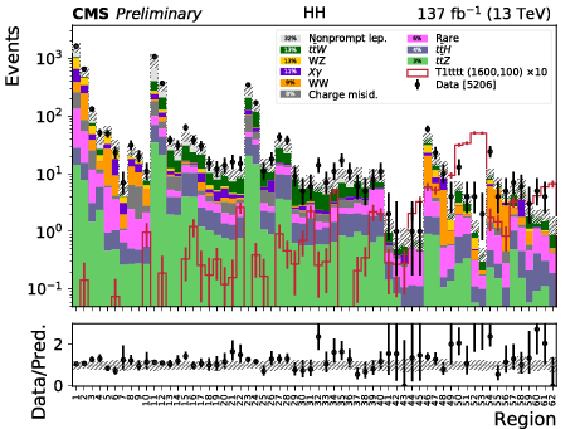
png pdf |
Figure 4-a:
Expected and observed SR yields for the SSHH signal category. |

png pdf |
Figure 4-b:
Expected and observed SR yields for the SSHL signal category. |

png pdf |
Figure 4-c:
Expected and observed SR yields for the SSLL signal category. |
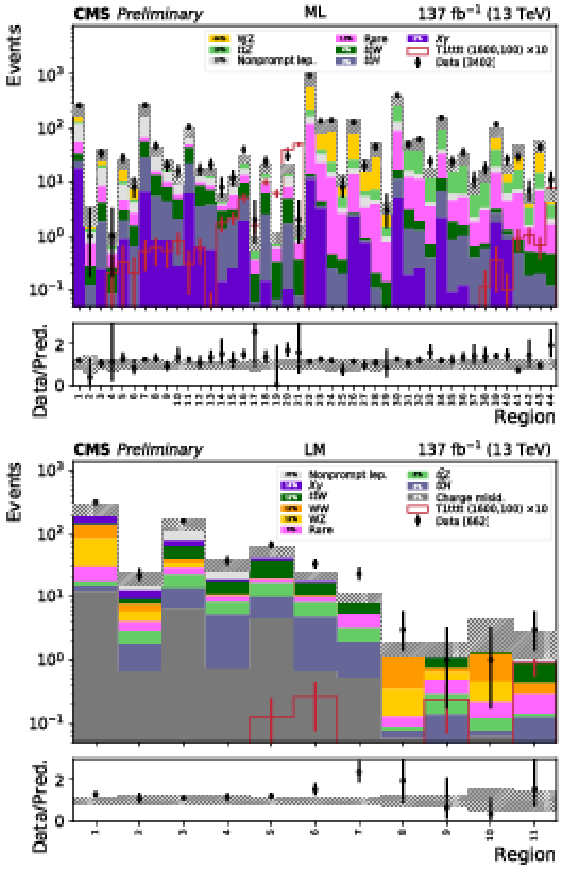
png pdf |
Figure 5:
Expected and observed SR yields for the ML and LM signal categories. |
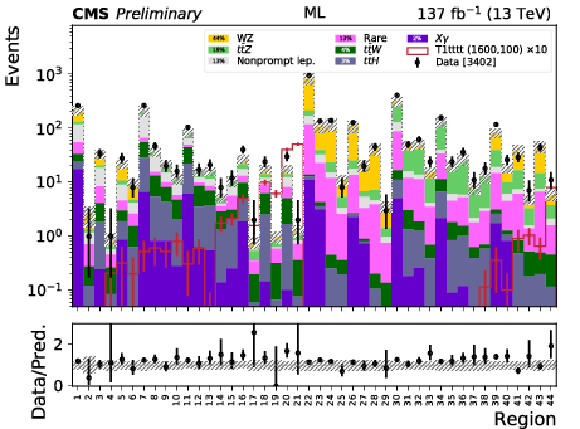
png pdf |
Figure 5-a:
Expected and observed SR yields for the ML signal category. |

png pdf |
Figure 5-b:
Expected and observed SR yields for the LM signal category. |

png pdf |
Figure 6:
Exclusion regions at 95% CL in the $m_{\tilde{\chi}^0_1}$ versus $m_{{\mathrm{\tilde{g}}}}$ plane for the T1tttt model (left), with off-shell third-generation squarks, and the T5tttt (right) model, with on-shell third-generation squarks. For the T5tttt model, $m_{\tilde{\mathrm{t}}} - m_{\tilde{\chi}^0_1} = m_{\mathrm{t}}$. The right-hand side color scale indicates the excluded cross section values for a given point in the SUSY particle mass plane. The solid, black curves represent the observed exclusion limits assuming the NLO+NLL cross sections [42,43,44,45,46,47] (thick line), or their variations of $\pm $1 standard deviation (thin lines). The dashed, red curves show the expected limits with the corresponding $\pm $1 and $\pm $2 standard deviation experimental uncertainties. Excluded regions are to the left and below the limit curves. |

png pdf |
Figure 6-a:
Exclusion regions at 95% CL in the $m_{\tilde{\chi}^0_1}$ versus $m_{{\mathrm{\tilde{g}}}}$ plane for the T1tttt model, with off-shell third-generation squarks. The right-hand side color scale indicates the excluded cross section values for a given point in the SUSY particle mass plane. The solid, black curves represent the observed exclusion limits assuming the NLO+NLL cross sections [42,43,44,45,46,47] (thick line), or their variations of $\pm $1 standard deviation (thin lines). The dashed, red curves show the expected limits with the corresponding $\pm $1 and $\pm $2 standard deviation experimental uncertainties. Excluded regions are to the left and below the limit curves. |

png pdf |
Figure 6-b:
Exclusion regions at 95% CL in the $m_{\tilde{\chi}^0_1}$ versus $m_{{\mathrm{\tilde{g}}}}$ plane for the T5tttt model, with on-shell third-generation squarks. For this model, $m_{\tilde{\mathrm{t}}} - m_{\tilde{\chi}^0_1} = m_{\mathrm{t}}$. The right-hand side color scale indicates the excluded cross section values for a given point in the SUSY particle mass plane. The solid, black curves represent the observed exclusion limits assuming the NLO+NLL cross sections [42,43,44,45,46,47] (thick line), or their variations of $\pm $1 standard deviation (thin lines). The dashed, red curves show the expected limits with the corresponding $\pm $1 and $\pm $2 standard deviation experimental uncertainties. Excluded regions are to the left and below the limit curves. |

png pdf |
Figure 7:
Exclusion regions at 95% CL in the plane of $m_{\tilde{\chi}^0_1}$ versus $m_{{\mathrm{\tilde{g}}}}$ for the T5qqqqWZ model with $m_{\tilde{\chi}^{\pm}_1}=0.5(m_{{\mathrm{\tilde{g}}}} + m_{\tilde{\chi}^0_1})$ (a) and with $m_{\tilde{\chi}^{\pm}_1} = m_{\tilde{\chi}^0_1}$ + 20 GeV (b). The notations are as in Fig. 6. |
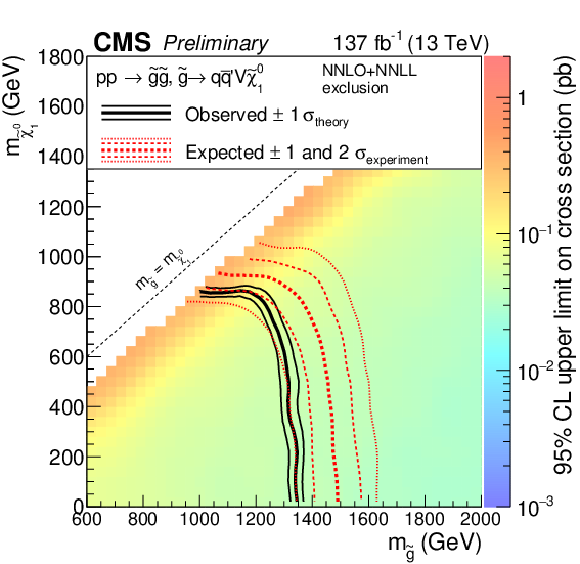
png pdf |
Figure 7-a:
Exclusion regions at 95% CL in the plane of $m_{\tilde{\chi}^0_1}$ versus $m_{{\mathrm{\tilde{g}}}}$ for the T5qqqqWZ model with $m_{\tilde{\chi}^{\pm}_1}=0.5(m_{{\mathrm{\tilde{g}}}} + m_{\tilde{\chi}^0_1})$. The notations are as in Fig. 6. |
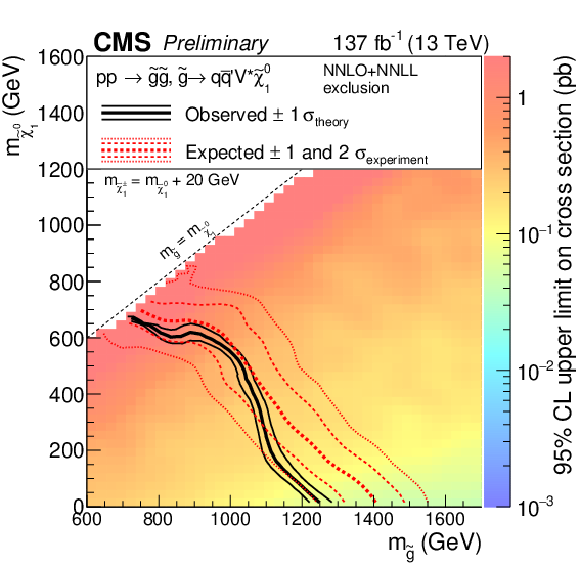
png pdf |
Figure 7-b:
Exclusion regions at 95% CL in the plane of $m_{\tilde{\chi}^0_1}$ versus $m_{{\mathrm{\tilde{g}}}}$ for the T5qqqqWZ model with $m_{\tilde{\chi}^{\pm}_1} = m_{\tilde{\chi}^0_1}$ + 20 GeV. The notations are as in Fig. 6. |
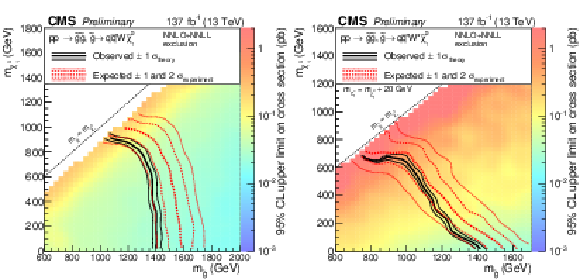
png pdf |
Figure 8:
Exclusion regions at 95% CL in the plane of $m_{\tilde{\chi}^0_1}$ versus $m_{{\mathrm{\tilde{g}}}}$ for the T5qqqqWW model with $m_{\tilde{\chi}^{\pm}_1}=0.5(m_{{\mathrm{\tilde{g}}}} + m_{\tilde{\chi}^0_1})$ (a) and with $m_{\tilde{\chi}^{\pm}_1} = m_{\tilde{\chi}^0_1}$ + 20 GeV (b). The notations are as in Fig. 6. |

png pdf |
Figure 8-a:
Exclusion regions at 95% CL in the plane of $m_{\tilde{\chi}^0_1}$ versus $m_{{\mathrm{\tilde{g}}}}$ for the T5qqqqWW model with $m_{\tilde{\chi}^{\pm}_1}=0.5(m_{{\mathrm{\tilde{g}}}} + m_{\tilde{\chi}^0_1})$. The notations are as in Fig. 6. |

png pdf |
Figure 8-b:
Exclusion regions at 95% CL in the plane of $m_{\tilde{\chi}^0_1}$ versus $m_{{\mathrm{\tilde{g}}}}$ for the T5qqqqWW model with $m_{\tilde{\chi}^{\pm}_1} = m_{\tilde{\chi}^0_1}$ + 20 GeV. The notations are as in Fig. 6. |
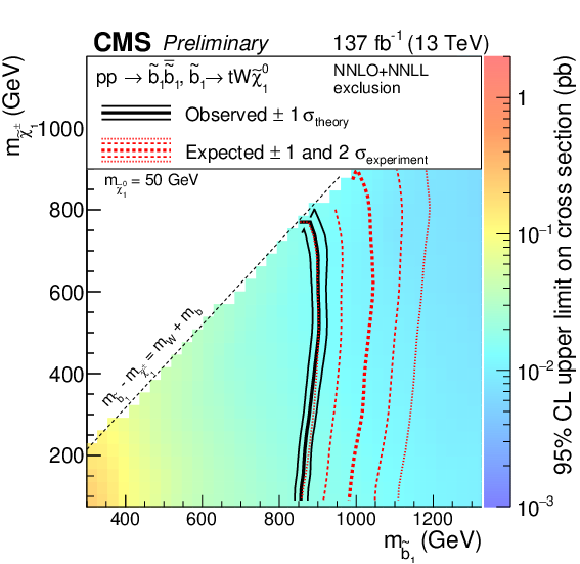
png pdf |
Figure 9:
Exclusion regions at 95% CL in the plane of $m_{\tilde{\chi}^{\pm}_1}$ versus $m_{\tilde{\mathrm{b}}}$ for the T6ttWW model with $m_{\tilde{\chi}^0_1} = $ 50 GeV. The notations are as in Fig. 6. |
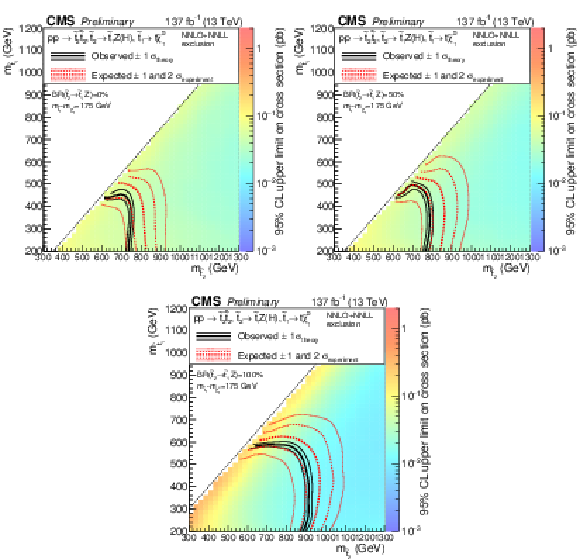
png pdf |
Figure 10:
Exclusion regions at the 95% CL in the plane of $m(\tilde{\mathrm{t}} _{1})$ versus $m(\tilde{\mathrm{t}} _{2})$ for the T6ttHZ simplified model with $m(\tilde{\mathrm{t}} _{2})-m(\tilde{\chi}^0_1) = $ 175 GeV. The three exclusions represent BR($\tilde{\mathrm{t}} _{2}\rightarrow \tilde{\mathrm{t}} _{1}\mathrm {Z})$ of 0%, 50%, and 100%, respectively. The right-hand side color scale indicates the excluded cross section values for a given point in the SUSY particle mass plane. Observed and expected limit curves indicate the boundaries of the excluded regions (to the left and below the curve). |
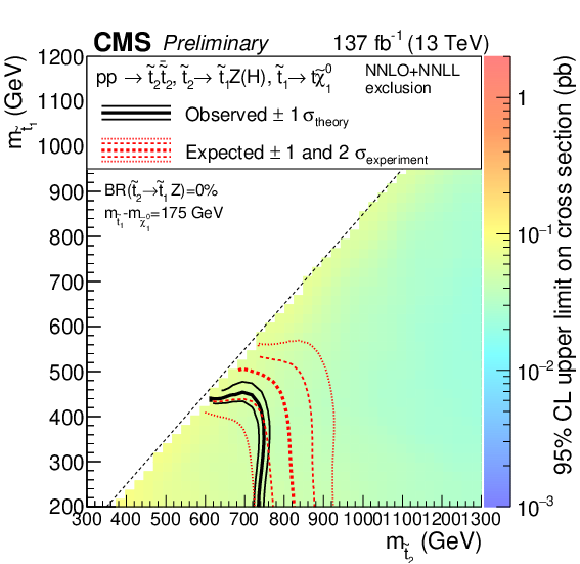
png pdf |
Figure 10-a:
Exclusion regions at the 95% CL in the plane of $m(\tilde{\mathrm{t}} _{1})$ versus $m(\tilde{\mathrm{t}} _{2})$ for the T6ttHZ simplified model with $m(\tilde{\mathrm{t}} _{2})-m(\tilde{\chi}^0_1) = $ 175 GeV and BR($\tilde{\mathrm{t}} _{2}\rightarrow \tilde{\mathrm{t}} _{1}\mathrm {Z})$ of 0%. The right-hand side color scale indicates the excluded cross section values for a given point in the SUSY particle mass plane. Observed and expected limit curves indicate the boundaries of the excluded regions (to the left and below the curve). |
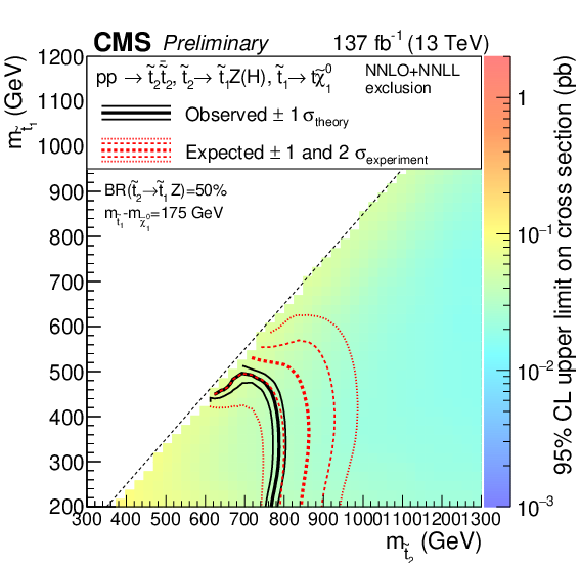
png pdf |
Figure 10-b:
Exclusion regions at the 95% CL in the plane of $m(\tilde{\mathrm{t}} _{1})$ versus $m(\tilde{\mathrm{t}} _{2})$ for the T6ttHZ simplified model with $m(\tilde{\mathrm{t}} _{2})-m(\tilde{\chi}^0_1) = $ 175 GeV and BR($\tilde{\mathrm{t}} _{2}\rightarrow \tilde{\mathrm{t}} _{1}\mathrm {Z})$ of 50%. The right-hand side color scale indicates the excluded cross section values for a given point in the SUSY particle mass plane. Observed and expected limit curves indicate the boundaries of the excluded regions (to the left and below the curve). |

png pdf |
Figure 10-c:
Exclusion regions at the 95% CL in the plane of $m(\tilde{\mathrm{t}} _{1})$ versus $m(\tilde{\mathrm{t}} _{2})$ for the T6ttHZ simplified model with $m(\tilde{\mathrm{t}} _{2})-m(\tilde{\chi}^0_1) = $ 175 GeV and BR($\tilde{\mathrm{t}} _{2}\rightarrow \tilde{\mathrm{t}} _{1}\mathrm {Z})$ of 100%. The right-hand side color scale indicates the excluded cross section values for a given point in the SUSY particle mass plane. Observed and expected limit curves indicate the boundaries of the excluded regions (to the left and below the curve). |

png pdf |
Figure 11:
Limits on RPV gluino pair production with each gluino decaying into four quarks and one lepton (T1qqqqL, left) and each gluino decaying into a top, bottom, and strange quark (T1tbs, right) |
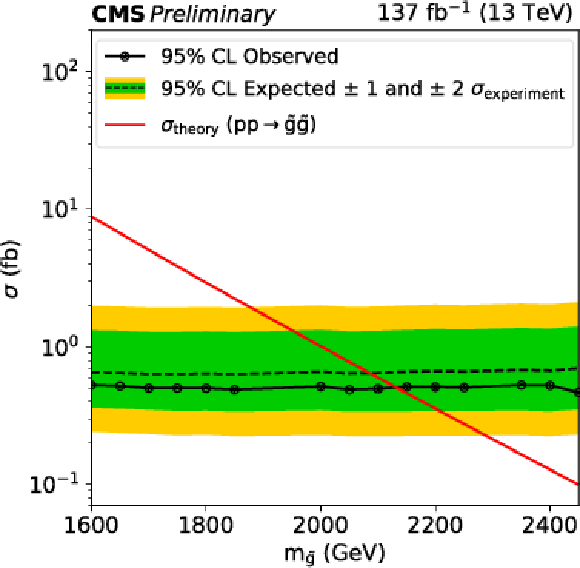
png pdf |
Figure 11-a:
Limits on RPV gluino pair production with each gluino decaying into four quarks and one lepton (T1qqqqL). |
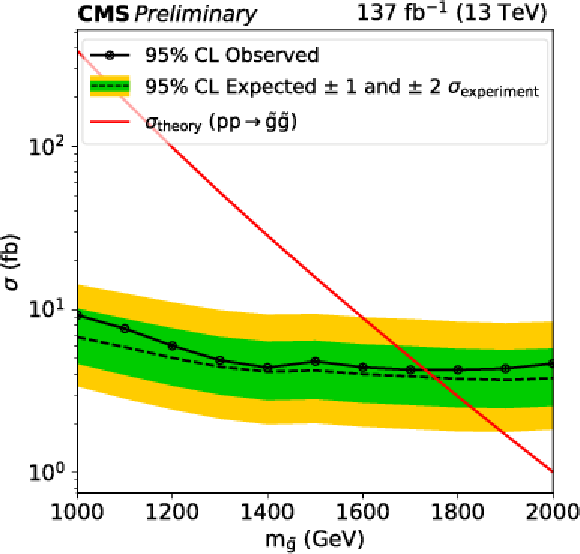
png pdf |
Figure 11-b:
Limits on RPV gluino pair production with each gluino decaying into a top, bottom, and strange quark (T1tbs). |
| Tables | |
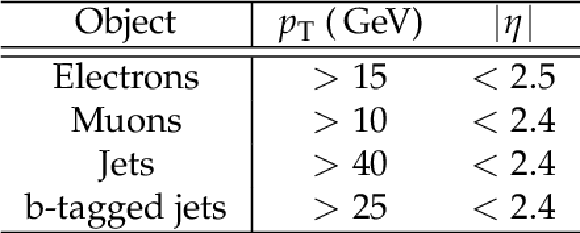
png pdf |
Table 1:
$ {p_{\mathrm {T}}} $ and $\eta $ requirements for leptons and jets. Note that the $ {p_{\mathrm {T}}} $ thresholds to count jets and b-tagged jets are different. |

png pdf |
Table 2:
SR definitions for the SSHH category. Charge split cells are indicated with ($++$) and ($--$). In order to avoid overlaps, an upper bound $ {{p_{\mathrm {T}}} ^\text {miss}} < $ 300 GeV is used for regions with $ {H_{\mathrm {T}}} > $ 300 GeV. There are 62 regions in total. |

png pdf |
Table 3:
SR definitions for the SSHL category. In order to avoid overlaps, an upper bound $ {{p_{\mathrm {T}}} ^\text {miss}} < $ 300 GeV is used for regions with $ {H_{\mathrm {T}}} > $ 300 GeV. There are 43 regions in total. |

png pdf |
Table 4:
SR definitions for the SSLL category. All SRs in this category require $ {N_\text {jets}} \geq $ 2. There are 8 regions in total. |

png pdf |
Table 5:
SR definitions for the LM category. All SRs in this category require $ {N_\text {jets}} \geq $ 2, $ {{p_{\mathrm {T}}} ^\text {miss}} < $ 50 GeV, $ {H_{\mathrm {T}}} > $ 300 GeV, and HH lepton momenta. The 2 high $ {H_{\mathrm {T}}} $ regions are split only by $ {N_\text {jets}} $, giving 11 regions in total. |

png pdf |
Table 6:
SR definitions for the ML category. All SRs in these categories require $ {N_\text {jets}} \geq $ 2. Regions marked with ${}^\dagger $ are split by $ {m_\mathrm {T}^{\text {min}}} = $ 120 GeV, with the high $ {m_\mathrm {T}^{\text {min}}} $ region specified by the second label. On-Z regions events include an OS same flavor lepton pair with 76 $ < m_{\ell \ell} < $ 106 GeV. There are 44 regions in total. |
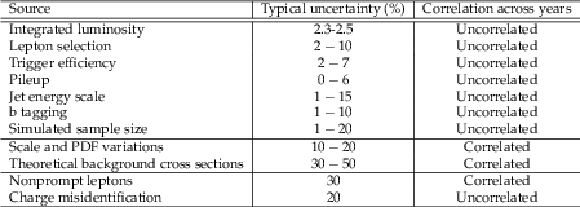
png pdf |
Table 7:
Summary of the sources of uncertainty and their effect on the yields of different processes in the SRs. The first two groups list experimental and theoretical uncertainties assigned to processes estimated using simulation, while the last group lists uncertainties assigned to processes whose yield is estimated from data. The uncertainties in the first group also apply to signal samples. Reported values are representative for the most relevant signal regions. |
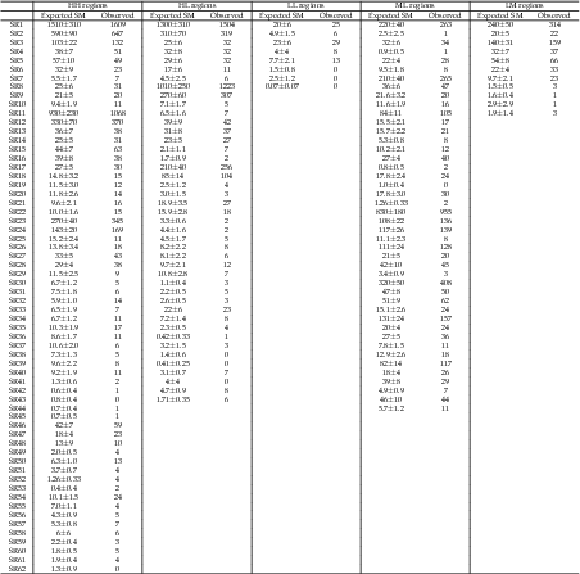
png pdf |
Table 8:
Expected background and observed event yields in the search regions used in this search. |
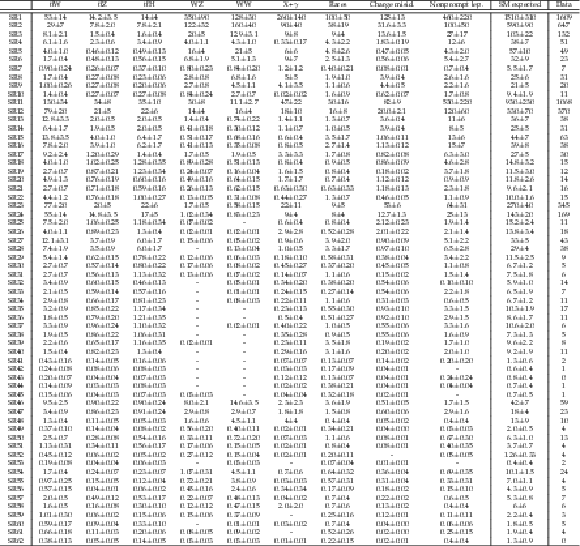
png pdf |
Table 9:
Event yields in HH regions. Yields shown as "-'' have a contribution smaller than 0.01, or do not contribute to a particular region. |

png pdf |
Table 10:
Event yields in HL regions. Yields shown as "-'' have a contribution smaller than 0.01, or do not contribute to a particular region. |

png pdf |
Table 11:
Event yields in LL regions. Yields shown as "-'' have a contribution smaller than 0.01, or do not contribute to a particular region. |

png pdf |
Table 12:
Event yields in ML regions. Yields shown as "-'' have a contribution smaller than 0.01, or do not contribute to a particular region. |

png pdf |
Table 13:
Event yields in LM regions. Yields shown as "-'' have a contribution smaller than 0.01, or do not contribute to a particular region. |
| Summary |
| A sample of same-sign dilepton or trilepton events produced in association with several jets in proton-proton collisions at 13 TeV, corresponding to an integrated luminosity of 137 fb$^{-1}$, has been studied to search for manifestations of physics beyond the standard model. The data are found to be consistent with the standard model expectations, and no excess event yield is observed. The results are interpreted as limits at 95% confidence level on cross sections for the production of new particles in simplified supersymmetric models, considering both RPC and RPV scenarios. Using calculations for these cross sections as functions of particle masses, the limits are turned into lower mass limits that are as high as 2.1 TeV for gluinos and 0.9 TeV for top and bottom squarks, depending on the details of the model. |
| References | ||||
| 1 | R. M. Barnett, J. F. Gunion, and H. E. Haber | Discovering supersymmetry with like-sign dileptons | PLB 315 (1993) 349 | hep-ph/9306204 |
| 2 | M. Guchait and D. P. Roy | Like-sign dilepton signature for gluino production at CERN LHC including top quark and Higgs boson effects | PRD 52 (1995) 133 | hep-ph/9412329 |
| 3 | Y. Bai and Z. Han | Top-antitop and top-top resonances in the dilepton channel at the CERN LHC | JHEP 04 (2009) 056 | 0809.4487 |
| 4 | E. L. Berger et al. | Top quark forward-backward asymmetry and same-sign top quark pairs | PRL 106 (2011) 201801 | 1101.5625 |
| 5 | T. Plehn and T. M. P. Tait | Seeking Sgluons | JPG 36 (2009) 075001 | 0810.3919 |
| 6 | S. Calvet, B. Fuks, P. Gris, and L. Valery | Searching for sgluons in multitop events at a center-of-mass energy of 8 TeV | JHEP 04 (2013) 043 | 1212.3360 |
| 7 | K. J. F. Gaemers and F. Hoogeveen | Higgs production and decay into heavy flavors with the gluon fusion mechanism | PLB 146 (1984) 347 | |
| 8 | G. C. Branco et al. | Theory and phenomenology of two-Higgs-doublet models | PR 516 (2012) 1 | 1106.0034 |
| 9 | F. M. L. Almeida, Jr. et al. | Same-sign dileptons as a signature for heavy Majorana neutrinos in hadron-hadron collisions | PLB 400 (1997) 331 | hep-ph/9703441 |
| 10 | R. Contino and G. Servant | Discovering the top partners at the LHC using same-sign dilepton final states | JHEP 06 (2008) 026 | 0801.1679 |
| 11 | ATLAS Collaboration | Search for supersymmetry in final states with two same-sign or three leptons and jets using 36 fb$ ^{-1} $ of $ \sqrt{s}=13 TeV pp $ collision data with the ATLAS detector | JHEP 09 (2017) 084 | 1706.03731 |
| 12 | CMS Collaboration | Search for physics beyond the standard model in events with two leptons of same sign, missing transverse momentum, and jets in proton-proton collisions at $ \sqrt{s} = $ 13 TeV | EPJC77 (2017), no. 9, 578 | CMS-SUS-16-035 1704.07323 |
| 13 | CMS Collaboration | Search for supersymmetry in events with at least three electrons or muons, jets, and missing transverse momentum in proton-proton collisions at $ \sqrt{s}= $ 13 TeV | JHEP 02 (2018) 067 | CMS-SUS-16-041 1710.09154 |
| 14 | P. Ramond | Dual theory for free fermions | PRD 3 (1971) 2415 | |
| 15 | Y. A. Gol'fand and E. P. Likhtman | Extension of the algebra of Poincar$ \'e $ group generators and violation of P invariance | JEPTL 13 (1971)323 | |
| 16 | A. Neveu and J. H. Schwarz | Factorizable dual model of pions | NPB 31 (1971) 86 | |
| 17 | D. V. Volkov and V. P. Akulov | Possible universal neutrino interaction | JEPTL 16 (1972)438 | |
| 18 | J. Wess and B. Zumino | A lagrangian model invariant under supergauge transformations | PLB 49 (1974) 52 | |
| 19 | J. Wess and B. Zumino | Supergauge transformations in four-dimensions | NPB 70 (1974) 39 | |
| 20 | P. Fayet | Supergauge invariant extension of the Higgs mechanism and a model for the electron and its neutrino | NPB 90 (1975) 104 | |
| 21 | H. P. Nilles | Supersymmetry, supergravity and particle physics | PR 110 (1984) 1 | |
| 22 | S. P. Martin | A supersymmetry primer | in Perspectives on Supersymmetry II, G. L. Kane, ed., p. 1 World Scientific, 2010 Adv. Ser. Direct. High Energy Phys., vol. 21 | |
| 23 | G. R. Farrar and P. Fayet | Phenomenology of the production, decay, and detection of new hadronic states associated with supersymmetry | PLB 76 (1978) 575 | |
| 24 | E. Nikolidakis and C. Smith | Minimal Flavor Violation, Seesaw, and R-parity | PRD77 (2008) 015021 | 0710.3129 |
| 25 | C. Smith | Minimal Flavor Violation as an alternative to R-parity | in Proceedings, 34th International Conference on High Energy Physics (ICHEP 2008): Philadelphia, Pennsylvania, July 30-August 5, 2008 2008 | 0809.3152 |
| 26 | C. Csaki, Y. Grossman, and B. Heidenreich | MFV SUSY: A Natural Theory for R-Parity Violation | PRD85 (2012) 095009 | 1111.1239 |
| 27 | J. Alwall et al. | The automated computation of tree-level and next-to-leading order differential cross sections, and their matching to parton shower simulations | JHEP 07 (2014) 079 | 1405.0301 |
| 28 | J. Alwall et al. | Comparative study of various algorithms for the merging of parton showers and matrix elements in hadronic collisions | EPJC 53 (2008) 473 | 0706.2569 |
| 29 | R. Frederix and S. Frixione | Merging meets matching in MC@NLO | JHEP 12 (2012) 061 | 1209.6215 |
| 30 | T. Melia, P. Nason, R. Rontsch, and G. Zanderighi | W$ ^+ $W$ ^- $, WZ and ZZ production in the POWHEG BOX | JHEP 11 (2011) 078 | 1107.5051 |
| 31 | P. Nason and G. Zanderighi | $ \mathrm{W}^+ \mathrm{W}^- $ , $ \mathrm{W} \mathrm{Z} $ and $ \mathrm{Z} \mathrm{Z} $ production in the POWHEG BOX V2 | EPJC 74 (2014) 2702 | 1311.1365 |
| 32 | NNPDF Collaboration | Parton distributions for the LHC Run II | JHEP 04 (2015) 040 | 1410.8849 |
| 33 | NNPDF Collaboration | Parton distributions from high-precision collider data | EPJC77 (2017), no. 10, 663 | 1706.00428 |
| 34 | T. Sjostrand et al. | An Introduction to PYTHIA 8.2 | CPC 191 (2015) 159--177 | 1410.3012 |
| 35 | P. Skands, S. Carrazza, and J. Rojo | Tuning PYTHIA 8.1: the Monash 2013 tune | EPJC 74 (2014) 3024 | 1404.5630 |
| 36 | CMS Collaboration | Event generator tunes obtained from underlying event and multiparton scattering measurements | EPJC 76 (2016) 155 | CMS-GEN-14-001 1512.00815 |
| 37 | CMS Collaboration | Extraction and validation of a new set of CMS PYTHIA8 tunes from underlying-event measurements | CMS-PAS-GEN-17-001 | CMS-PAS-GEN-17-001 |
| 38 | GEANT4 Collaboration | $ GEANT4\ $ ---$ \ $ a simulation toolkit | NIMA 506 (2003) 250 | |
| 39 | S. Abdullin et al. | The fast simulation of the CMS detector at LHC | J. Phys. Conf. Ser. 331 (2011) 032049 | |
| 40 | CMS Collaboration | Measurements of $ t\bar{t} $ cross sections in association with $ b $ jets and inclusive jets and their ratio using dilepton final states in pp collisions at $ \sqrt{s} = $ 13 TeV | PLB776 (2018) 355--378 | CMS-TOP-16-010 1705.10141 |
| 41 | W. Beenakker et al. | NNLL-fast: predictions for coloured supersymmetric particle production at the LHC with threshold and Coulomb resummation | JHEP 12 (2016) 133 | 1607.07741 |
| 42 | W. Beenakker, R. Hopker, M. Spira, and P. M. Zerwas | Squark and gluino production at hadron colliders | NPB 492 (1997) 51 | hep-ph/9610490 |
| 43 | A. Kulesza and L. Motyka | Threshold resummation for squark-antisquark and gluino-pair production at the LHC | PRL 102 (2009) 111802 | 0807.2405 |
| 44 | A. Kulesza and L. Motyka | Soft gluon resummation for the production of gluino-gluino and squark-antisquark pairs at the LHC | PRD 80 (2009) 095004 | 0905.4749 |
| 45 | W. Beenakker et al. | Soft-gluon resummation for squark and gluino hadroproduction | JHEP 12 (2009) 041 | 0909.4418 |
| 46 | W. Beenakker et al. | Squark and gluino hadroproduction | Int. J. Mod. Phys. A 26 (2011) 2637 | 1105.1110 |
| 47 | C. Borschensky et al. | Squark and gluino production cross sections in pp collisions at $ \sqrt{s} = $ 13, 14, 33 and 100 TeV | EPJC 74 (2014) 3174 | 1407.5066 |
| 48 | D. Alves et al. | Simplified models for LHC new physics searches | JPG 39 (2012) 105005 | 1105.2838 |
| 49 | CMS Collaboration | Interpretation of searches for supersymmetry with simplified models | PRD 88 (2013) 052017 | CMS-SUS-11-016 1301.2175 |
| 50 | CMS Collaboration | The CMS experiment at the CERN LHC | JINST 3 (2008) S08004 | CMS-00-001 |
| 51 | CMS Collaboration | The CMS trigger system | JINST 12 (2017) P01020 | CMS-TRG-12-001 1609.02366 |
| 52 | CMS Collaboration | Particle-flow reconstruction and global event description with the cms detector | JINST 12 (2017) P10003 | CMS-PRF-14-001 1706.04965 |
| 53 | CMS Collaboration | Performance of electron reconstruction and selection with the CMS detector in proton-proton collisions at $ \sqrt{s} = $ 8 TeV | JINST 10 (2015) P06005 | CMS-EGM-13-001 1502.02701 |
| 54 | CMS Collaboration | Performance of CMS muon reconstruction in pp collision events at sqrt(s) = 7 TeV | JINST 7 (2012) P10002 | CMS-MUO-10-004 1206.4071 |
| 55 | M. Cacciari, G. P. Salam, and G. Soyez | The anti-$ k_t $ jet clustering algorithm | JHEP 04 (2008) 063 | 0802.1189 |
| 56 | M. Cacciari, G. P. Salam, and G. Soyez | FastJet user manual | EPJC 72 (2012) 1896 | 1111.6097 |
| 57 | CMS Collaboration | Jet energy scale and resolution in the CMS experiment in pp collisions at 8 TeV | JINST 12 (2016) P02014 | CMS-JME-13-004 1607.03663 |
| 58 | CMS Collaboration | Jet algorithms performance in 13 TeV data | CMS-PAS-JME-16-003 | CMS-PAS-JME-16-003 |
| 59 | CMS Collaboration | Identification of heavy-flavour jets with the CMS detector in pp collisions at 13 TeV | JINST 13 (2018), no. 05, P05011 | CMS-BTV-16-002 1712.07158 |
| 60 | CMS Collaboration | Performance of missing transverse momentum in pp collisions at sqrt(s)=13 TeV using the CMS detector | CMS-PAS-JME-17-001 | CMS-PAS-JME-17-001 |
| 61 | CMS Collaboration | Search for new physics in same-sign dilepton events in proton-proton collisions at $ \sqrt{s} = $ 13 TeV | EPJC 76 (2016) 439 | CMS-SUS-15-008 1605.03171 |
| 62 | CMS Collaboration | Determination of jet energy calibration and transverse momentum resolution in CMS | JINST 6 (2011) P11002 | CMS-JME-10-011 1107.4277 |
| 63 | CMS Collaboration | Performance of the CMS missing transverse momentum reconstruction in pp data at $ \sqrt{s} = $ 8 TeV | JINST 10 (2015) P02006 | CMS-JME-13-003 1411.0511 |
| 64 | CMS Collaboration | CMS Luminosity Measurements for the 2016 Data Taking Period | CMS-PAS-LUM-17-001 | CMS-PAS-LUM-17-001 |
| 65 | CMS Collaboration | Measurement of the inelastic proton-proton cross section at $ \sqrt{s}= $ 13 TeV | JHEP 07 (2018) 161 | CMS-FSQ-15-005 1802.02613 |
| 66 | A. Kalogeropoulos and J. Alwall | The SysCalc code: A tool to derive theoretical systematic uncertainties | 1801.08401 | |
| 67 | ATLAS Collaboration | Measurement of the $ t\bar{t}Z $ and $ t\bar{t}W $ cross sections in proton-proton collisions at $ \sqrt{s}= $ 13 TeV with the ATLAS detector | 1901.03584 | |
| 68 | CMS Collaboration | Measurement of the cross section for top quark pair production in association with a W or Z boson in proton-proton collisions at $ \sqrt{s} = $ 13 TeV | JHEP 08 (2018) 011 | CMS-TOP-17-005 1711.02547 |
| 69 | T. Junk | Confidence level computation for combining searches with small statistics | NIMA 434 (1999) 435 | hep-ex/9902006 |
| 70 | A. L. Read | Presentation of search results: the $ CL_S $ technique | JPG 28 (2002) 2693 | |
| 71 | ATLAS and CMS Collaborations | Procedure for the lhc higgs boson search combination in summer 2011 | ATL-PHYS-PUB-2011-011, CMS NOTE-2011/005 | |
| 72 | G. Cowan, K. Cranmer, E. Gross, and O. Vitells | Asymptotic formulae for likelihood-based tests of new physics | EPJC 71 (2011) 1554 | 1007.1727 |

|
Compact Muon Solenoid LHC, CERN |

|

|

|

|

|

|